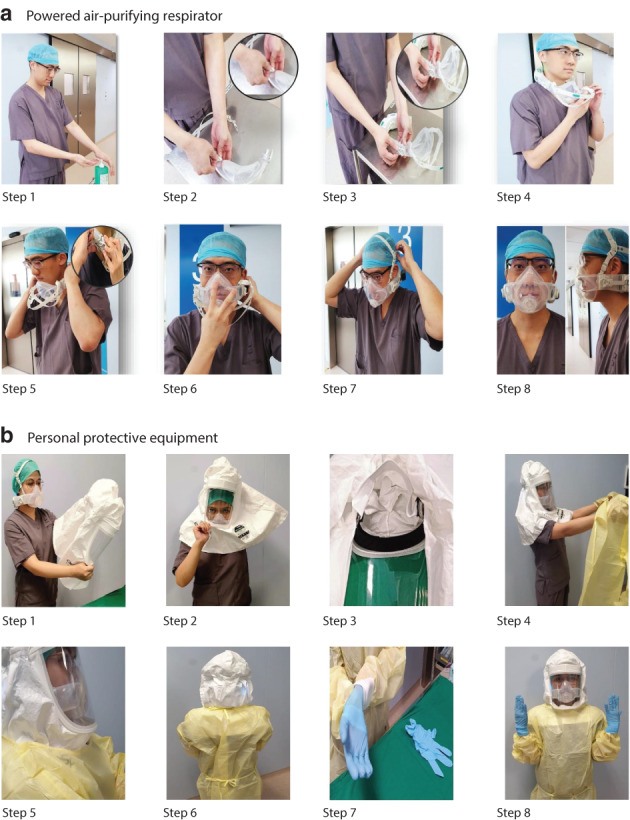Editor
Aerosol-generating procedures (AGP), like intubation, endoscopy and laparoscopy, may transmit the SARS-CoV-2 virus during this COVID-19 pandemic1,2. This has led to guidelines urging cancellation of elective surgery and emphasizing caution during laparoscopy3–5. Our protocols and workflows during the COVID-19 outbreak are described here.
For suspected or confirmed COVID-19 cases, a pressure-controlled operating room is recommended to prevent viral dissemination beyond the theatre. This consists of four interconnected rooms, in which two anterooms (induction and scrub), with a lower atmospheric pressure than the operating room, are sealed by interlocking doors with air drop seals. Simulation of procedures improves safety and reliability during high stress environments, and advanced personal protective equipment (PPE) and powered air-purifying respirators (PAPR) are used (Fig. 1). Only the most senior anaesthesiologist and two assistant nurses are present during induction. After intubation and extubation, a lockdown period of 5 min is allowed for air cleaning (two air exchanges), or 15 min if laparoscopy was used. Patients recover within contained environments and specific wards according to viral presence/absence.
Fig. 1.
Guide to donning powered air-purifying respirators and personal protective equipment

a Powered air-purifying respirator (PAPR; CleanSpace® HALO ™, CleanSpace Technology Pty Ltd, Artarmon, New South Wales, Australia). Step 1, use hand rub (seven steps); step 2, ensure harness is clipped securely to mask; 3, clip mask to CleanSpace HALO and switch it on; 4, put CleanSpace HALO around neck; step 5, clip CleanSpace HALO into place; step 6, put on mask; step 7, pull harness up to crown of head and adjust mask; step 8, PAPR ready for use. b Personal protective equipment (PPE). Step 1, hold the visor in one hand and the inner hood with the other; 2, pull on hood using outer hand and guide hood down; step 3, once hood is on, ensure black foam is in contact with forehead; step 4, adjust hood if necessary and don PPE; step 5, tuck hood inside PPE; step 6, tie PPE, ensuring the back is well covered and the CleanSpace blower is not blocked; step 7, don gloves, ensuring wrists are covered; step 8, PPE ready for use. Images reproduced with permission.
Despite initial concerns reflected in several guidelines, our hospital has continued to safely undertake time-sensitive elective and emergency operations during the outbreak without negative events arising. Others have described positive experiences with careful practice6, and we should use this knowledge in the second and third waves of COVID-197. It is ethically responsible to recommence caring for patients with disease requiring intervention despite the challenges of the pandemic8. The advantages of telemedicine and technology are apparent9, and smart use of local resources will provide safe care for surgical patients.
References
- 1. Søreide K, Hallet J, Matthews JB, Schnitzbauer A, Line PA, Lai PBSet al. Immediate and long-term impact of the COVID-19 pandemic on delivery of surgical services. Br J Surg 2020; 10.1002/bjs.11670 [Epub ahead of print]. [DOI] [PMC free article] [PubMed] [Google Scholar]
- 2. Spinelli A, Pellino G. COVID-19 pandemic: perspectives on an unfolding crisis. Br J Surg 2020; 10.1002/bjs.11627 [Epub ahead of print]. [DOI] [PMC free article] [PubMed] [Google Scholar]
- 3. COVIDSurg Collaborative . Global guidance for surgical care during the COVID-19 pandemic. Br J Surg 2020; 10.1002/bjs.11646 [Epub ahead of print]. [DOI] [PMC free article] [PubMed] [Google Scholar]
- 4. Di Marzo F, Sartelli M, Cennamo R, Toccafondi G, Coccolini F, La Torre Get al. Recommendations for general surgery activities in a pandemic scenario (SARS-CoV-2). Br J Surg 2020; 10.1002/bjs.11652 [Epub ahead of print]. [DOI] [PMC free article] [PubMed] [Google Scholar]
- 5. Mowbray NG, Ansell J, Horwood J, Cornish J, Rizkallah P, Parker Aet al. Safe management of surgical smoke in the age of COVID-19. Br J Surg 2020; 10.1002/bjs.11679 [Epub ahead of print]. [DOI] [PMC free article] [PubMed] [Google Scholar]
- 6. Cai M, Wang G, Zhang L, Gao J, Xia Z, Zhang Pet al. Performing abdominal surgery during the COVID-19 epidemic in Wuhan, China: a single-centred, retrospective, observational study. Br J Surg 2020; 10.1002/bjs.11643 [Epub ahead of print]. [DOI] [PMC free article] [PubMed] [Google Scholar]
- 7. Mayol J, Fernandez PC. Elective surgery after the pandemic: waves beyond the horizon. Br J Surg 2020; 10.1002/bjs.11688 [Epub ahead of print]. [DOI] [PMC free article] [PubMed] [Google Scholar]
- 8. Ives J, Huxtable R. Surgical ethics during a pandemic: moving into the unknown. Br J Surg 2020; 10.1002/bjs.11638 [Epub ahead of print]. [DOI] [PubMed] [Google Scholar]
- 9. Vogler SA, Lightner AL. Rethinking how we care for our patients in a time of social distancing. Br J Surg 2020; 10.1002/bjs.11636 [Epub ahead of print]. [DOI] [PMC free article] [PubMed] [Google Scholar]


